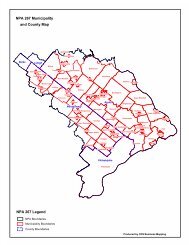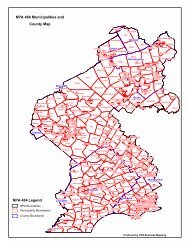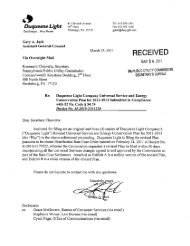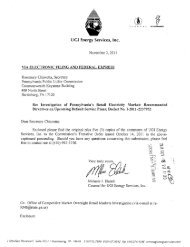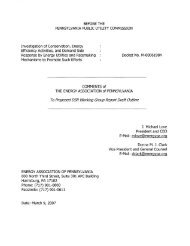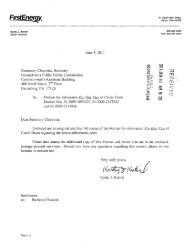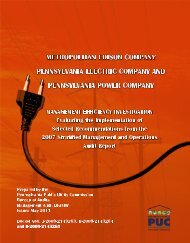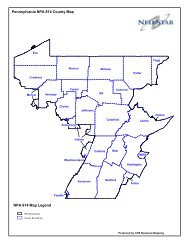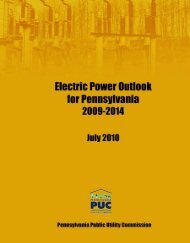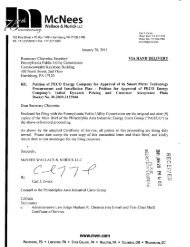Final Smart Meter Plan-Duquesne Light - Pennsylvania Public Utility ...
Final Smart Meter Plan-Duquesne Light - Pennsylvania Public Utility ...
Final Smart Meter Plan-Duquesne Light - Pennsylvania Public Utility ...
Create successful ePaper yourself
Turn your PDF publications into a flip-book with our unique Google optimized e-Paper software.
<strong>Duquesne</strong> <strong>Light</strong>Tishekia WilliamsSenior Counsel, RegulatoryVIA OVERNIGHT MAILMs. Rosemary Chiavetta, Secretary<strong>Pennsylvania</strong> <strong>Public</strong> <strong>Utility</strong> CommissionPO Box 3265Hamsburg, PA 17105-3265411 Seventh Avenue16 m FloorPittsburgh, PA 15219August 2, 20 i 3Tel 412-393-1541Fax 412-393-5757twilliams@duqlight.comRECEIVEDAUG-2 2013PA PUBLIC UTILITY COMMISSIONSECRETARY'S BUREAURE:<strong>Duquesne</strong> <strong>Light</strong> Company - <strong>Smart</strong> <strong>Meter</strong> Procurement and Installation <strong>Plan</strong>Docket No.: M-2009-2123948Dear Secretary Chiavetta:<strong>Duquesne</strong> <strong>Light</strong> Company ("<strong>Duquesne</strong> <strong>Light</strong>" or "Company") hereby submits it's <strong>Final</strong><strong>Smart</strong> <strong>Meter</strong> Procurement and Installation <strong>Plan</strong> Compliance Filing as required by the<strong>Pennsylvania</strong> <strong>Public</strong> <strong>Utility</strong> Commission ("Commission") Order issued May 6, 2013 in the abovereferenced docket.Also, Appendix A to the filing includes responses to the Company's Request forInfonnation ("RFI") and contains infonnation that <strong>Duquesne</strong> <strong>Light</strong> considers to be confidentialand proprietary infonnation. These pages have been marked Confidential and are enclosed inseparate envelopes. <strong>Duquesne</strong> <strong>Light</strong> requests that the copies of the materials that have beenmarked Confidential and are contained in the Confidential envelopes be given confidentialtreatment by the Commission, including its various offices and bureaus. That is, <strong>Duquesne</strong>requests that the confidential materials be excluded from the Commission's public documentfolder and that confidential copies not be disclosed to the public. <strong>Duquesne</strong> <strong>Light</strong> will providethe Confidential infonnation contained in Appendix A to record parties of this proceeding uponthe execution of a confidentiality agreement.Please do not hesitate to contact me with questions, comments or concerns.a RespectfulEnclosurescc: Certificate of ServicTishekia WilliamsSenior Counsel, Regulatory
BEFORE THEPENNSYLVANIA PUBLIC UTILITY COMMISSIONPetition of <strong>Duquesne</strong> <strong>Light</strong> CompanyFor Approval of Its <strong>Final</strong> <strong>Smart</strong> <strong>Meter</strong>Procurement And Installation <strong>Plan</strong>DocketNo. M-2009-212DECEIVEDI. INTRODUCTIONDUQUESNE LIGHT COMPANY_ * ^ntoSMART METER PROCUREMENT AND INSTALLATIONCOMPLIANCE FILING p Ap U B L I C U T I U T YCOMMISSIONSECRETARY'S BUREAUOn May 6, 2013, the <strong>Pennsylvania</strong> <strong>Public</strong> <strong>Utility</strong> Commission ("Commission") enteredits Opinion and Order ("May 6 Order") granting the Petition of <strong>Duquesne</strong> <strong>Light</strong> Company("<strong>Duquesne</strong> <strong>Light</strong>" or the "Company") for Approval of its <strong>Final</strong> <strong>Smart</strong> <strong>Meter</strong> Procurement andInstallation <strong>Plan</strong> ("<strong>Final</strong> <strong>Smart</strong> <strong>Meter</strong> <strong>Plan</strong>") at the above-captioned docket. The Commissiondirected <strong>Duquesne</strong> <strong>Light</strong> to make a compliance filing within 90 days of the May 6 Orderspecifying its proposed changes to settlements and profile processes and providing datasupporting whether or not inclusion of the voltage monitoring and communication of outages andrestorations capabilities are cost effective. 1This filing is submitted in compliance with the May6 Order. 2In this filing, the Company explains its PJM settlement and profde processes which willuse hourly data available through the installation of smart meters to directly assign energy coststo each customer on the Advanced <strong>Meter</strong>ing Infrastructure ("AMI") system based on their actualhourly usage. Also, the Company details its approach to implementing advanced outagecommunications and voltage monitoring capabilities, provides supporting order of magnitude1The Mav 6' h Order also discusses 3 rd parly data access. In compliance with llie Commission's December6, 2012 <strong>Smart</strong> <strong>Meter</strong> order issued at Docket No. M-2009-2092655. <strong>Duquesne</strong> <strong>Light</strong> filed a <strong>Smart</strong> <strong>Meter</strong> Supplementaddressing 3 rdparty data access on April 4, 2013. In lhat filing, the Company indicated that il is participating fullyin the Electronic Data Exchange Working Group (EDEWG) Web-Portal workgroup. The Company's <strong>Smart</strong> <strong>Meter</strong>Supplement was accepted by Secretarial Letter issues July 2, 2013.2Interested parties may file comments to this compliance filing within 120 days of the May 6 Order, orSeptember 3, 2013.I0Q4M15VI
cost-benefit data, requests approval to begin implementing an electrical model and develop amore defined roadmap for advanced outage and voltage capabilities and associated cost benefitanalysis in 2014.II.BACKGROUND1. On June 29, 2012, the Company filed a Petition for Approval of its <strong>Final</strong> <strong>Smart</strong><strong>Meter</strong> <strong>Plan</strong>. On December 7, 2012, <strong>Duquesne</strong> <strong>Light</strong> and the Office of Consumer Advocate filedan uncontested Joint Petition for Approval of Full Settlement. The Joint Petition proposed toresolve all issues related to the Company's smart meter implementation including deploymentschedule and technology solutions.2. On January 24, 2013, Administrative Law Judge Katrina Dunderdale issued anInitial Decision approving the Joint Petition for Settlement. In its May 6 Order, the Commissionapproved the <strong>Final</strong> <strong>Smart</strong> <strong>Meter</strong> <strong>Plan</strong>, and required the Company to propose changes to PJMsettlements and profile processes to fully enable Time-of-Use ("TOU") rates, and provide datasupporting whether or not inclusion of the voltage monitoring and communication of outages andrestorations capabilities are cost effective.III.PJM SETTLEMENT AND TOU PRICING3. Pursuant to Act 129 of 2008, <strong>Duquesne</strong> <strong>Light</strong> is required to deploy "smart metertechnology" that enables the use of time-of-use ("TOU") rates and real time pricing ("RTP")among other capabilities. 66 Pa. C.S. § 2807(g).4. In its May 6 Order, the Commission correctly noted that in order to fully enableTOU and RTP, <strong>Duquesne</strong> <strong>Light</strong> must obtain and use hourly usage data for each customer forpurposes of PJM settlement.5. Under the current processes, the Company uses hourly data that is available forPJM settlement. Presently, hourly data is available for approximately 1,000 commercial and
industrial ("C&l") customers with interval meters. This data is extracted from the MV-90system and accounts for approximately 48% of the Company's total system load. The Companythen uses daily meter read data that is available from its current advanced meter reading("AMR") system. The meters of all residential customers and the balance of the C&I customersnot having interval meters are read through the AMR system. Since hourly meter read data isnot available from the AMR system, the Company extracts the daily reads from the AMRsystem, detennines daily kWh consumption, then uses rate class temperature and load profiles toallocate the daily kWh consumption to each hour of the day. For unmetered customers, theCompany utilizes calculated average daily kWh consumption based on account type that isallocated to each hour of the day based on the load profile of the applicable rate class (e.g. streetlighting customer daily kWh consumption is allocated to applicable street lighting hours ofoperation).6. The Company's current use of hourly data and the load profiles for PJMsettlement is a function of existing technology limitations. Hourly usage data is not available forall customers using the Company's existing AMR system. The Company will continue toemploy the same PJM settlement process currently in effect as smart meters are deployed. TheCompany will first use hourly data that is available for PJM settlement, then use rate class loadand temperature profiles to allocate daily consumption data to each hour of the day for thebalance of the load. AMI data will be used immediately upon becoming available. As hourlyusage data becomes available for all customers through the installation of the AMI System 3 , thebalance of the load on the AMR system will decline. Under this process the Company will3The AMI system will consist of four primary components: (I) a Head-End Data Collection System, (2)new ITRON <strong>Smart</strong> <strong>Meter</strong>s, (3) a Local Area Network that allows smart meters to communicate with other metersand/or collection points throughout the service territory, and (4) a Wide Area Network which is the communicationpathway from the collectors/towers located throughout the Company's service territoiy to the AMI Head-EndSystem.3
directly assign energy to each hour of the day for each customer on the AMI system according totheir actual usage as recorded by the smart meter. This will enable customers with a smart meterinstalled on their premise to participate in TOU and RTP programs.IV.ADVANCED OUTAGE COMMUNICATIONS/ RESTORATION AND VOLTAGEMONITORING7. In the Commission's <strong>Smart</strong> <strong>Meter</strong> Procurement and Installation ImplementationOrder {"SM Implementation Order") electric distribution companies ("EDCs") were directed toinstall smart meter technology. EDCs were further directed to examine the costs and benefitsassociated with several functionalities that were not mandated by Act 129, including the abilityto communicate outages and restorations, and monitor voltage at each meter and report data in amanner that allows the EDC to react. <strong>Smart</strong> <strong>Meter</strong> Procurement and Installation ImplementationOrder entered on June 24, 2009, at Docket No. M-2009-2092655.8. The Commission further acknowledged that the costs of these added capabilitiesmay exceed benefits they may provide. Accordingly, the Commission reserved the authority towaive the requirement for these capabilities as well as any of the other Commission imposedrequirements (that exceeded the minimum requirements imposed by Act 129) upon a finding thatthe costs exceed the benefits of the capabilities. Id. at. 30-31. In its May 6 Order, theCommission directed <strong>Duquesne</strong> <strong>Light</strong> to provide cost-benefit information to justify whether ornot outage communications and voltage monitoring functionality should be implemented. 44In the Company's <strong>Final</strong> <strong>Smart</strong> <strong>Meter</strong> <strong>Plan</strong>, it did not propose to implement advanced outage monitoringand communicaiion and voltage monitoring capabilities. As discussed more fully within, based on informationgained from super storm Sandy and further research, the Company believes that the benefits of implementingadvanced outage communication and voltage monitoring, both monetary and intangible, potentially warrantimplementation.
9. Preliminarily, the Company notes that the benefits that can be achieved from AMIimplementation are directly correlated to the existing utility infrastructure and systems in place.The more advanced the existing systems, the less operational benefits may be achieved. Thirdparty support for this position can be found, among other places, in the U.S. Department ofEnergy (DOE) study entitled "U.S Department of Energy, Operations and Maintenance Savingsfrom Advanced <strong>Meter</strong>ing Infrastructure - Initial Results " (December 2012). In this study, theDOE states "Those utilities lhat have implemented AMR systems over the last several decades, havealready gained operational savings from fewer manual meter reads and truck rolls for service calls.As a result, implementation of AMR affects the amount of operational savings that can be achievedfrom the transition to investments in AMI."a. <strong>Duquesne</strong> <strong>Light</strong>'s Current Systems and Infrastructure10. <strong>Duquesne</strong> <strong>Light</strong> implemented an advanced meter reading ("AMR") system in1997. Presently, eighty-five (85) percent of <strong>Duquesne</strong> <strong>Light</strong> customers are served from theexisting AMR system.11. Moreover, the Company's smart meter plan includes the replacement of the AMRsystem with AMI. AMI includes a Head-End Data Collection System, Local Area Network,Wide Area Network, and ITRON smart meters. ITRON smart meters have the ability tocommunicate outages and restorations at the meter.12. Distribution automation is an advanced capability that can be enhanced with AMIimplementations. In the simplest tenns, distribution automation is the real-time monitoring andcontrol of devices on the distribution system to control voltage, reroute power, and restoreservice. In the past, distribution automation has been used by utilities to varying degrees,largely to monitor and control devices at the major device level. Distribution automation can be
enhanced by an AMI implementation by providing the ability to monitor and control devicesdown to the meter level.13. <strong>Duquesne</strong> <strong>Light</strong>'s distribution system includes 23kV and 4kV radial distributioncircuits, 23kv sub-transmission lines, and a secondary network system serving DowntownPittsburgh. Approximately 60 percent of <strong>Duquesne</strong> <strong>Light</strong> customers are served from the 23k Vradial distribution circuits. The Company's 23kV protection devices consist of substationbreakers, 3 phase sectionalizers, 3 phase reclosers, line fuses, secondary network limiters, andcompletely self protected ("CSP") transformers. The 23kV voltage control devices includesubstation load tap changing (LTC) transformers, regulators and capacitor banks. All 23kVsubstation breakers, 23kv sectionalizers and reclosers, and all network protectors are SupervisoryControl And Data Acquisition ("SCADA") controllable. 5In addition, all 23kV LTCtransformers, regulators and capacitor banks are also SCADA controlled. <strong>Duquesne</strong> <strong>Light</strong>'s23kV distribution system is completely automated and provides instantaneous outagenotification, voltage detection and loading information as well as the ability to restores service,raise or lower voltage on feeders, and reroute power to alleviate overloads. 614. <strong>Duquesne</strong> <strong>Light</strong> has an Outage Analysis System ("OAS") that is used to trackemergency trouble calls, provides a means to manually group these calls to protective devices,and enables real time updating of the interactive voice response ("IVR") with useful outageinfonnation for customers to hear. In addition to OAS, Storm Tracker, which is a DLC softwareapplication, is used to manage outages during severe weather conditions.5The protective devices on 4kV lines consist of substation breakers, single phase oil reclosers, line fuses,transformer fuses and CSP transformers. These devices are not SCADA controlled.f>The outage and voltage detection informalion is provided at the major device level, as opposed to themeter level.
15. Through its SCADA system, the Company employs distribution automationwhich is leveraged for service restoration via remote switching, voltage control of distributioncircuits, and rerouting power to alleviate overloads. The benefit of such automation is reflectedin the Company's reliability metrics. Likewise, the Company's AMR implementation hasresulted in significant operational savings from the elimination of manual meter reads, andreduced truck rolls more than a decade ago.16. Nonetheless, the Company believes that the incremental benefits that can beachieved warrant the additional investment required to implement advanced outagecommunications, restoration and voltage monitoring capabilities. As demonstrated by recentstonns, customer's expectations related to reliability are increasing. Customers value theopportunity for improved reliability afforded by smart grid and smart meter deployment. Thirdparty support for this statement can be found in a study conducted by the <strong>Smart</strong> Grid ConsumerCollaborative ("SGCC") entitled Spotlight on Low Income Consumers <strong>Final</strong> Report. SGCC'sresearch indicates that reliability is considered the greatest value added to low income customers.Spotlight on Low Income Consumers <strong>Final</strong> Report p. 6. Accordingly, as the smart gridtechnology advances and proven technologies are introduced in the market, <strong>Duquesne</strong> <strong>Light</strong>must continue to invest in state of art technologies in order to maintain the high quality, safe andreliable service that its customers have come to expect.17. To implement advanced outage communication and voltage monitoringcapability, at a minimum the Company will have to replace its current OAS with an OutageManagement System (OMS) and develop an electrical model. An electric model is necessary asit connects the customer to the grid and models the electrical connectivity from the substationbreaker all the way to the meter. An OMS uses the electrical model to automatically determinewhat protective device has operated during a power outage and then automatically groups all7
customers beyond this device together. The outage notification feature of smart meters can beincorporated into an OMS to help identify what protective device has opened and then verify thatall customers have been restored once repairs arc completed.b. Potential Outage Communication, Restoration and Voltage MonitoringCapabilities18. Given the nature of the Company's existing infrastructure and systems, <strong>Duquesne</strong><strong>Light</strong> is primarily evaluating three advanced capabilities that, if implemented, will provideenhanced outage communication and restoration, and voltage monitoring capabilities. Thesecapabilities include 1) Volt/VAR optimization, 2) Outage Notification, and 3) TransformerLoading. The three capabilities discussed arc not inclusive but rather examples of capabilitieswith the potential to provide substantia] benefits. For example, the Company will also evaluateopportunities to use features such as tamper alerts to energy diversion and predictive analytics toassist in transformer load planning.19. VAR optimization can produce an efficiency improvement from power factorcorrection and is considered an enabler for voltage optimization. Voltage optimization is anelectrical energy saving technique that can create capacity demand reductions at peak conditionsand can also improve power quality. In a distribution system, power flow to the feeder includes"real power flow" and "reactive power flow." <strong>Duquesne</strong> <strong>Light</strong> can potentially reduce line lossesand improve the voltage profile along the feeder by reducing the amount of reactive power("VARs") flowing on the distribution feeder.20. OMS and AMI data can be leveraged to improve outage notification capabilitiesand improve circuit reliability in many cases. Subcategories of benefits are faster faultidentification, reduced search time, and locating nested outages faster by receiving quick
feedback from meters as to whether all the outages on a circuit have been fixed while crews arestill on-site.21. Overloaded distribution transformers are often the result of customers installingair conditioners or other electrical load and can result in power outages to customers during peakload times. Implementing technology that improves the ability to identify transfonnersapproaching their limit before they overload can prevent an outage and potentially extend the lifeof the equipment.22. As previously indicated, each of these capabilities require, at minimum, an OMSand the electrical model. Replacing the existing OAS and implementing an electrical model is afoundational requirement to delivering any of the enhanced capabilities explained in this filing.Implementation of these advanced capabilities requires substantial planning and is a multi-year,multimillion dollar undertaking.c. Cost-Benefit Analysis and Implementation Roadmap23. To aid in the development, evaluation and planning process for the OMS andElectrical Model, <strong>Duquesne</strong> <strong>Light</strong> issued a Request for Information ("RFI") to solicit conceptualproposals from industry experts regarding advanced outage communication and voltagemonitoring technology and cost-benefit infonnation. The Company received responses from twoexperienced industry experts. The confidential responses provided by the industry experts areenclosed and marked Appendix A.24. The companies provided <strong>Duquesne</strong> <strong>Light</strong> with high level cost and benefit data forthe advanced capabilities discussed herein. Based on the information provided by these industryexperts, <strong>Duquesne</strong> <strong>Light</strong> currently estimates that the costs for implementing an OMS system,electrical model and additional technology that will deliver the advanced capabilities discussed
herein would range from $22,000,000 to $44,000,000. 7The broadness of this range is indicativeof the preliminary nature of the estimate and difficulty in providing certain cost in the absence ofa full study.25. Benefits from advanced outage communication and voltage monitoring mayinclude, but are not limited to, improved customer communication during outages including theability to proaetively communicate with customers regarding service disruptions, reduced lineloss opportunities, operational efficiencies such as improved crew management and assetmanagement, as well as providing opportunities to improve power quality, operate equipmentmore efficiently, and implement conservation and demand response programs.26. Without a detailed study it is difficult to monetize the benefits expected fromimplementing advanced outage communication, restoration and voltage monitoring capabilities.Costs and benefits are driven by a combination of logic, variables and data, many of which areunknown at this time.However, preliminary estimates indicate that the Company maypotentially achieve benefits ranging from $120,000,000 to $250,000,000 over a 20 year period.These estimates are provisional, and subject to change based on the outcome of a detailed studyof the Company's distribution systems and infrastructure and potential changes in future costs. Itis also important to note that the models used by industry experts to generate order of magnitudebenefits are based on an integrated utility model.7This is an order of magnitude estimate wilh a 70% confidence level. Additional work is required to refinetlie costs and benefits data and develop llie roadmap for implementation.
27. Nonetheless, the intangible benefits of implementing advanced outagecommunication, restoration and voltage monitoring capabilities are significant. As demonstratedby recent events such as super storm Sandy, customers expect more communication and fasterrestoration. Within reason, the Company must invest in state of art technologies to continueproviding safe and reliable service that its customers expect.28. Presently, <strong>Duquesne</strong> <strong>Light</strong> envisions implementing Volt/VAR optimization,outage notification and transfonner loading capabilities in three (3) phases. Phase I is theStrategic Development Phase. Phase I of the project will include a more detailed study ofdistribution operations processes and technology, data collection as well as an implementationroadmap. The Company expects that Phase II will focus on implementation of advanced outagecapabilities and Phase III will focus on distribution applications. However, until the StrategicDevelopment Phase is complete, the costs, benefits and exact scope of work to be completed inPhases II and III are tentative and subject to change. Enclosed and marked Appendix B is atimeline that illustrates the current implementation strategy pending further review during PhaseI and Commission approval.29. Based on the results of Phase I, the Company will provide the Commission andinterested parties with its implementation roadmap including specific capabilities supportingtechnology recommendations and refined cost-benefit infonnation. Subject to Commissionapproval, Phase I will commence in the fourth quarter of 2014. Also, in the fourth quarter of2014, the Company will begin collecting data required for the creation of an electrical model inthe fliture. As previously discussed, the Company cannot implement advanced outage or voltagecapabilities without building an electrical model.
30. Following competition of the Phase 1 study, the Company will petition theCommission tor approval to implement specific advanced outage communication, restorationand voltage monitoring capabilities consistent with the information gathered during Phase 1 -Strategic Development. 8V. CONCLUSIONWHEREFORE, <strong>Duquesne</strong> <strong>Light</strong> Company requests that the <strong>Pennsylvania</strong> <strong>Public</strong> <strong>Utility</strong>Commission:1) Approve this filing and attached appendices as compliant with the CommissionMay 6 Order; and2. Authorize <strong>Duquesne</strong> <strong>Light</strong> to begin Phase I - Strategic Development of its OutageCommunication, Restoration and Voltage Monitoring <strong>Plan</strong> and data collection; and3) Authorize <strong>Duquesne</strong> <strong>Light</strong> to recover its interim and actual costs for the Phase Istudy and data collection through the smart meter charge, estimated at $1-$1.5million. The Company will petition the Commission for approval to implementspecific advanced outage and voltage capabilities and cost recovery following thecompletion of Phase I.8For customers to benefit from the advanced capabilities discussed in this filing, implementation must becoordinated with the Company's broader AMI deployment. Tlie Company intends to complete the installation of theelectrical model by the time there is a critical mass of smart meters deployed. Moreover, the Company anticipatesthat its current AMI meter deployment may be altered, although not delayed, by the extensive work required lo layerin the outage and voltage capabilities discussed herein. It is too early to determine the precise impact to the AMIplan. If it is detenuined that modifications to (he AMI deployment plan are required, the Company will include thatinformation in its post-Phase I filing.12
Respectfully submitted,Michael W. Gang (ID # 25670)Anthony D. Kanagy (ID #85522)Post & Schell, P.C.17 North Second Street, 12 ,1, FloorHarrisburg, PA 17101-1601Phone:(717) 731-1970Fax: (717) 731-1985E-mail:mgang@postschell.comE-mail:akanagy@postschell.comfsnekia Williams<strong>Duquesne</strong> <strong>Light</strong> Company411 Seventh AvenuePittsburgh, PA 15219Phone: (412) 393-1541Fax: (412) 393-5757E-mail:Twilliams@duqlight.comAttorneys for <strong>Duquesne</strong> <strong>Light</strong> CompanyDate: August 2, 2013RECEIVEDAUG -2 2013PA PUBLIC UTILITY COMMISSIONSECRETARY'S BUREAU13
BEFORE THEPENNSYLVANIA PUBLIC UTILITY COMMISSION<strong>Duquesne</strong> <strong>Light</strong> Company <strong>Smart</strong> <strong>Meter</strong>Procurement and Installation <strong>Plan</strong>DocketNo. M-2009-2123948VERIFICATIONI, Joan M. Flinko, being an agent of <strong>Duquesne</strong> <strong>Light</strong> Company, state that I am authorizedto make this Verification on behalf of <strong>Duquesne</strong> <strong>Light</strong> Company that the facts and informationset forth in the foregoing <strong>Final</strong> <strong>Smart</strong> <strong>Meter</strong> Procurement and Installation <strong>Plan</strong> ComplianceFiling are true and correct to the best of my knowledge, informalion and belief, and I expect tobe able to prove the same at any hearing held in this matter. I understand that the statementsherein are made subject to the penalties of 18 Pa.C.S. § 4904 relating to unsworn falsification toauthorities.Date: August 2, 2013 rfoalfi M. Flinkoi^lnager, AMI ProgramRECEIVEDAUG - 2 2013PA PUBLIC UTILITY COMMISSIONSECRETARY'S BUREAU
RECEIVEDAUG - 2 2013PA PUBLIC UTILITY COMMISSIONSECRETARY'S BUREAU
Conceptual SM Timeline with outage & voltage<strong>Duquesne</strong> <strong>Light</strong>Our Energy... Your Power•Bi-directionalcommunication•Remote <strong>Meter</strong>Programming•Hourly Usage Data•HourlyConsumption•TOU/TPR•Net <strong>Meter</strong>ing•RemoteConnect/Disconnect•15 Minute IntervalData•VoltageMonitoring*•OutageNotification'2014201520162017201820192020•Cumulativemeter installs5k90k198k306k414k532k600kEstimate DLC Outage/Voltage Timeline*Create and Maintain Electric Model 6/2014 - 6-2018Phase 16/2014-6/2015Phase 1 - Strategic Development•Study of distribution operations processes & technologies•Implementation planning•Refined cost/benefit detail•Recovery planningPhase 2 6/2015 - 6/2018Phase 2 - Advance Outage Capabilities•Implement an OMS•Advanced Outage Communications•Advanced Restoration ProcessesPhase 3 1/2018-12/2020"Timeline is on estimate and subjectto Phase 1 study results. Phasecapabilities ore a representativesample and are not limited to theitems listed. The bullets are alsosubject to change."As currently approved in the filing.Phase 3 - Advanced Distribution Capabilities1/2018 -12/2020"Implement DMS•VOLT/VAR•Transformer Loading•Improved power quality
CERTIFICATE OF SERVICEI hereby certify that a true and correct copy of the foregoing has been served upon the followingpersons, in the manner indicated, in accordance with the requirements of § 1.54 (relating to service by aparticipant):VIA FIRST-CLASS MAILJohnnie B. Simms, EsquireBureau of Investigation & EnforcementCommonwealth Keystone Building400 North Street, 2nd Floor WestPO Box 3265Harrisburg, PA 17105-3265Tanya McCIoskey, EsquireDavid Evrard, EsquireOffice of Consumer Advocate555 Walnut StreetForum Place, 5th FloorHarrisburg, PA 17101-1923Pamela C. Polacek, EsquireTeresa K. Schmittberger, EsquireMcNees Wallace & Nurick LLC100 Pine Street, PO Box 1166Harrisburg, PA 17108-1166Counsel for DIIDivesh Gupta, EsquireAssistant General CounselConstellation Energy Group, Inc.100 Constellation Way, Suite 500CBaltimore, MD 21202Counsel for Constellation Energy GroupRECEIVEDAUG - 2 2013PA PUBLIC UTILITY COMMISSIONSECRETARY'S BUREAUDated August 2,2013Sharon E. Webb, EsquireOffice of Small Business Advocate300 North Second Street, Suite 1102Harrisburg, PA 17101Harry S. Geller, Esquire<strong>Pennsylvania</strong> <strong>Utility</strong> Law Project118 Locust StreetHarrisburg, PA 17101Counsel for ACORNTheodore S. Robinson, EsquireCitizen Power Inc.2121 Murray AvenuePittsburgh, PA 15217Counsel for Citizen Power Inc.Kimberly H. Childe, EsquirePA Department of Environmental ProtectionRCSOB, 9th Floor400 Market SlreetHarrisburg, PA 17101-2301Counsel for DEPScott H. DeBroff, EsquireAlicia R. Petersen, EsquireRhoads & Sinon LLPOne South Market Square12th Floor, PO Box 1146Harrisburg, PA 17108-1146Counsel for Enernoc Inc.1Tishekia Williams, Esq.<strong>Duquesne</strong> <strong>Light</strong> Company411 Seventh Avenue, 16 1 FloorPittsburgh, PA 15219412-393-1541 (phone)/412-393-5757 (fax)twilliams@duqliuht.com
UPS CampusShip: Shipment Label Page 1 of 1UPS CampusShip: View/Print Label1. Ensure there are no other shipping or tracking labels attached to your package. Select the Print button on the printdialog box that appears. Note: If your browser does not support this function select Print from the File menu to print thelabel.I. Fold the printed sheet containing the label at the line so that the entire shipping label is visible. Place the label ona single side of the package and cover it completely with clear plastic shipping tape. Do not cover any seams orclosures on the package with the label. Place the label in a UPS Shipping Pouch. If you do not have a pouch, affix thefolded label using clear plastic shipping tape over the entire label.3. GETTING YOUR SHIPMENT TO UPSUPS locations include the UPS Store®, UPS drop boxes, UPS customer centers, authorized retail outlets and UPSdrivers.Schedule a same day or future day Pickup to have a UPS driver pickup all your CampusShip packages.Hand the package to any UPS driver in your area.Take your package to any location of The UPS Store®, UPS Drop Box, UPS Customer Center, UPS Alliances (OfficeDepot® or Staples®) or Authorized Shipping Outlet near you. Items sent via UPS Return Services(SM) (including viaGround) are also accepted at Drop Boxes. To find the location nearest you, please visit the Resources area ofCampusShip and select UPS Locations.oCustomers with a Daily PickupYour driver will pickup your shipment(s) as usual.FOLD HEREoCM•ONoiLOCOoCOoONrHoChoXoNif2hltps://www.campusship.ups.coiTi/cship/create?ActionOriginPair=default Print WindowPage&ke... 8/2/2013



